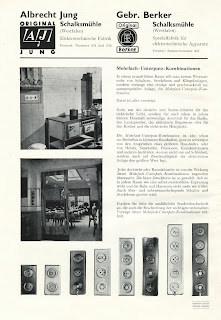Berker
It's a Berker. Wet dream of every collector -as they say.
Many people think it's the rarest WW2 flashlight, but it's not really true in my opinion. If you want it, you can buy it in some kind of condition, any time. The keyword is the condition.
The filter knob is always missing. The bakelite is rigid, it can easily break off from the metal axle. The switch on the top is the same, mostly missing. The red opener buttons too, rare in intact condition.The condition that I show now is ultra rare.
But little history first. The Berker company was started in 1919 in Schalksmühle.
The company was not ruined after the war, they continued the work, and still exist today.
Started by brothers Robert and Hugo Berker. This is readable everywhere. But I got more information from a family member. In fact, there were three brothers, Robert Berker, Hugo Berker and Gustav Berker.
I know this, because I bought this flashlight from Gustav Berker's grandchild.
That is the reason why this item is so special to me. It's a rare type, in rare condition, and I got this from a Berker family descendant, that is the most important thing to me.
The company produced various connectors and switches, (that is why they survived the war) these are made of bakelite and porcelain mostly.
The flashlight manufacturing only was a side track.
I think they wanted a little piece from the big cake of the war industry.
The logo of the company. Gebrüder Berker Schalksmühle. The outline of the logo is a shape of an old type of bakelite switch.
The Berker brothers started the company when the Bauhaus design style started, in 1919. This is easily recognizable on their early products.
The Nazi regime not really liked the Bauhaus school and style, maybe that is the reason, but it's not sure. The Zeiler (on the right), the bigest bakelite flashlight producer in the period, produced much more Bauhaus-like flashlights.
Same period, similar flashlights, but different solutions.
Yes, it has a green filter knob, really few made with green knob, mostly it’s light blue.
The blue light under the central part. The green arm drive a simple bakelit plane inside, which is cover up and down the lightbeam.
Many collectors think that it is the most beautiful wartime flashlight.
I don’t want to decide this, but yes, it’s a really special piece.
Overall, the bakelite was not the best idea for a field flashlight material. It's fragile.
It has a lot of design mistakes. The filter knobs are mostly broken at the first few uses. The switch is fragile too, but big, easier to use like the smaller metall ones on the other period types.
The red buttons on the sides can break down quickly too, the metal shaft is small in the bakelite cast.
That is one of the reasons why it is one of the most expensive wartime flashlights. It's really hard to find in intact condition.
An in house picture from the factory in 1947. A couple of years before the photo the flashlights made too in similar simple production line.
Full length morse table on the front.
One big aluminium rivet connect of the bottom and top part.
The red buttons on the side open the top.
Really nice detailed logo.
The reflector is made of very good quality. Much better than the other types in the period.
The logo, the molding number, and the M-PAD mark. And a little "GERMANY" label below.
In the M-PAD mark the "80" is mean the producer: "Gebrüder Berker, Schalksmühle".
The "Z" is mean: Phenolic resin (bakelite) with cellulose as a filler, and the "1" is mean Phenolic resin (bakelite) with inorganic (mineral) filler.
The "Z" is mean: Phenolic resin (bakelite) with cellulose as a filler, and the "1" is mean Phenolic resin (bakelite) with inorganic (mineral) filler.
Really detailed impressive molding.
And last, a picture about the field use.
Wartime Flashlights
All rights reserved ©
2022
All rights reserved ©
2022






























Comments
Post a Comment